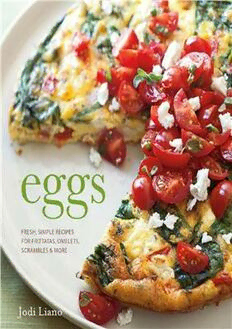
Eggs: Fresh, Simple Recipes For Frittatas, Omelets, Scrambles & More PDF
Preview Eggs: Fresh, Simple Recipes For Frittatas, Omelets, Scrambles & More
recipes Jodi Liano photographs Kate Sears Contents introduction out of the frying pan omelets and scrambles frittatas baked egg dishes other egg dishes basic recipes fillings menu ideas basic techniques index why eat eggs? One of the most healthful foods, eggs are perfectly proportioned protein powerhouses encased in a handy little package. They are also incredibly versatile, whether used in sweet or savory dishes, eaten on their own or used as the building block for countless fabulous dishes. a note about salt All of the recipes in this book were prepared using kosher salt, which has a coarser grain than standard iodized salt, making it easy to grasp with your fingertips. Its light salty taste means you might use slightly more than standard salt, so always season to taste, especially when finishing a dish. Sea salt is also an excellent option, with its delicate white crystals and fine mineral taste. From creamy mounds of scrambled eggs and fluffy omelets stuffed with cheese to delicate quiche with flaky crusts and hearty vegetable-studded frittatas, eggs are one of the most multipurpose ingredients you can find. Whether fried, poached, scrambled, baked, or boiled, used whole or separated, they are talented kitchen performers. They can be eaten by themselves or added to dishes from around the world to provide flavor, color, and consistency. Eggs are the quintessential breakfast and brunch ingredient, but they are also suitable for a light lunch when paired with a fresh salad, or even as part of a hearty supper. The simple yet inspiring dishes found in this book include both classic comforts such as Quiche Lorraine, Toad in the Hole, and Deviled Eggs, as well as creative new ideas such as Eggs Baked in Tomatoes, Curried Eggs, and Egg, Bacon, and Brie Panini, that are sure to become part of your standard repertoire. On their own, eggs supply a weath of vitamins, minerals, protein, and fat. In fact, egg whites are among the most healthful of foods, being both low in fat and high in protein. And while egg yolks contain most of the fat and cholesterol found in an egg, they also provide the most flavor. the anatomy of an egg There are five basic parts to every egg: shell, membrane, chalazae, yolk, and white. The oval-shaped shell is one of the strongest shapes found in nature. The inner and outer membranes protect the egg from bacteria and help keep the egg moist. The yolk contains some protein, most of the vitamins and minerals, and all of the fat. The white protects the yolk and contains most of the protein, which is one reason it is so good for us and why it whips up so well. The cloudy strings are called the chalazae, which hold the yolk in the center of the egg white. buying and storing eggs SIZE Eggs are sized according to their weight, from small to jumbo. The most popular size is large, which is the size used for the recipes in this book. FRESHNESS Eggs are graded AA, A, and B according to the quality of the shell and the thickness and clarity of the whites. Grade AA eggs have clean, unbroken shells, thick whites, and round, bright yolks, and are best for frying or poaching, while grade A eggs are fine for blended eggs and egg dishes. Grade B eggs are typically sold to manufacturers. STORAGE Always store your eggs in the same carton that you bought them in on a shelf in the refrigerator. The cardboard carton helps eggs retain a proper moisture balance, which adds to their shelf life. Refrigerated, eggs should remain fresh for up to 4 weeks past their sell-by date on the carton. You can also store eggs at a cool room temperature for up to a day or two. understanding egg carton labels Purchasing the best-quality eggs from a humane source is often confusing because of the many labels found on cartons. While colorful eggs from local farms are always a treat and probably the freshest you’ll find, that’s not an option for most of us. Certified organic eggs mean that the hens are fed an organic, vegetarian diet with no antibiotics or pesticides, per official USDA guidelines. They are uncaged, often with access to the outdoors. Free-range hens are uncaged and have some access to the outdoors, but there are no official USDA standards, and this label does not describe the diet of the hens. Certified humane and cage-free labels mean the birds are uncaged indoors, but do not often have access to the outside.
